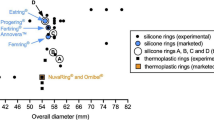Abstract
Objective: To validate an acceptability questionnaire for NuvaRing®, a new combined contraceptive vaginal ring.
Methods: A 21-item questionnaire was developed covering: ease of ring use, ease of package use, clarity of instructions, sexual comfort, cycle-related characteristics, compliance and satisfaction. A total of 2145 women completed the questionnaire after 3, 6 or 13 cycles of NuvaRing® use. The psychometric properties and predictive value of the questionnaire were assessed using cycle 3 data (n = 1950). The quality of completed questionnaires, item content analysis, construct validity, internal consistency reliability, known groups validity and predictive validity were evaluated.
Results: Excluding non-ordinal items, 0.6% of the data were missing. Principal component analysis of 15 ordinal items indicated that two hypothesised dimensions (‘ease of package use’ and ‘clarity of instructions’ were consistently linked and so were combined into a single‘ ease of comprehension’ scale. Item convergent validity (the degree of correlation between an item and its own scale) was 100% for ‘ease of ring use’ (r = 0.44) and ‘satisfaction’ (r = 0.58), 83% for ‘ease of comprehension’ (r = 0.25–0.62) and 67% (r = 0.38–0.54) for ‘sexual comfort’, but 0% for ‘cycle-related characteristics’ (r = 0.31). Item discriminant validity (the degree to which an item correlates with its own scale compared with other scales) was ≥96% for all dimensions. Internal consistency reliability was acceptable for all dimensions (adjusted Cronbach’s α coefficient >0.70). Satisfaction was higher than in the complementary groups for respondents who had no adverse events, chose NuvaRing® as the best method of contraception or completed the study; this indicated good known groups validity. Low satisfaction with the method was a good predictor of early discontinuation after cycle 3, indicating that the questionnaire had good predictive validity.
Conclusions: The acceptability questionnaire has good psychometric properties and can predict early discontinuation of the NuvaRing® vaginal ring method of contraception.








Similar content being viewed by others
Notes
The use of trade names is for product identification purposes only and does not imply endorsement.
References
Ruusuvaara L, Johansson ED. Contraceptive strategies for young women in the 21st century. Eur J Contracept Reprod Health Care 1999; 4 (4): 255–63
Vree ML, Schmidt J. A large observational clinical evaluation of a desogestrel-containing combiphasic oral contraceptive in Germany. Eur J Contracept Reprod Health Care 2001; 6 (2): 108–14
Burkmann RT. Oral contraceptives: current status. Clin Obstet Gynecol 2001; 44 (1): 62–72
Pharmacia & Upjohn Inc. International survey of birth control methods and what women want [online]. Available from URL: http://www.birthcontrolresources.com [Accessed 2001 Sep 21]
Westhoff C. Criteria for appropriate birth control. Gynecol Endocrinol 2001; 15 Suppl. 3: 19–22
Coukell AJ, Balfour JA. Levonorgestrel subdermal implants: a review of contraceptive efficacy and acceptability. Drugs 1998; 55 (6): 861–87
Burkmann RT. Compliance and other issues in contraception. Int J Fertil Womens Med 1999; 44 (5): 234–40
Branden PS. Contraceptive choice and patient compliance: the health care provider’s challenge. J Nurse Midwifery 1998; 43 (6): 471–82
Schulman LP. Controlled trial with a monthly injectable contraceptive in the USA. Gynecol Endocrinol 2001; 15 Suppl. 3: 15–8
Kaunitz AM. Lunelle monthly injectable contraceptive: an effective, safe, and convenient new birth control option. Arch Gynecol Obstet 2001; 265 (3): 119–23
Peterson AE, Perez-Escamilla R, Labboka MH, et al. Multicenter study of the lactational amenorrhea method (LAM) III: effectiveness, duration and satisfaction with reduced clientprovider contact. Contraception 2000; 62 (5): 221–30
Oddens BJ. Women’s satisfaction with birth control: a population survey of physical and psychological effects of oral contraceptives, intrauterine devices, natural family planning, and sterilisation among 1466 women. Contraception 1999; 59 (5): 277–86
Kirkman RJ, Bromham DR, O’Connor TP, et al. Prospective multicentre study comparing norgestrel implants with a combined contraceptive pill: final results. Br J Fam Plann 1999; 25 (2): 36–40
Sulak P, Lippman J, Siu C, et al. Clinical comparison of triphasic norgestimate/35 micrograms ethinyl estradiol and monophasic northindrone acetate/20 micrograms ethinyl estradiol: cycle control, lipid effects and user satisfaction. Contraception 1999; 59 (3): 161–6
Del Carmen Cravioto M, Alvarado G, Canto-de-Cetina T, et al. A multicenter comparative study on the efficacy, safety and acceptability of the contraceptive subdermal implants Norplant and Norplant II. Contraception 1997; 55 (6): 359–67
Rosenfield JA, Zahorik PM, Saint W, et al. Women’s satisfaction with birth control. J Fam Pract 1993; 36 (2): 169–73
Spencer BE, Jones V, Elstein M. The acceptability of the contraceptive vaginal ring. Br J Fam Plann 1986; 12: 82–7
Novak A, de la Loge C, Abetz L. Validation of NuvaRing acceptability questionnaire. Poster presented at the Meetings of the International Society of Quality of Life Research; 2001 Nov 7–10; Amsterdam
Novak A, de la Loge C, Abetz L. Evaluation of NuvaRing acceptability in 14 countries. Poster presented at International Federation of Fertility Societies 17th World Congress on Fertility and Sterility; 2001 Nov 25–30; Melbourne
Novak A, de la Loge C, Abetz L. The combined contraceptive vaginal ring, NuvaRing: an international study of user acceptability. Contraception 2003 Mar; 67 (3): 187–94
Lohr KN, Aranson NK, Alonso J, et al. Evaluating quality-oflife and health status instruments: development of scientific review criteria. Clin Ther 1996; 18 (5): 979–92
Van de Vijver F, Leung K. Methods and data analysis for crosscultural research. Thousand Oaks (CA): Sage Publications, 1997
Roumen FJME, Apter D, Mulders TMT, et al. Efficacy, tolerability and acceptability of a novel contraceptive vaginal ring releasing etonogestrel and ethinyl oestradiol. Hum Reprod 2001; 16: 469–75
Dieben TOM, Roumen FJME, Apter D. Efficacy, cycle control and user acceptability of a novel combined contraceptive vaginal ring. Obstet Gynecol 2002 Sep; 100 (3): 585–93
Hays R, Anderson R, Revicki DA. Assessing reliability and validity of measurement in clinical trials. In: Staquet MJ, Hays RD, Fayers PM, editors. Quality of life assessment in clinical trials. New York: Oxford University Press, 1998: 169–82
Nunnally JC. Psychometric theory. New York: McGraw-Hill, 1978
Cronbach LJ. Coefficient alpha and the internal structure of tests. Psychometrika 1951; 16: 297–334
Ware Jr JE, Kosinski M, Gandek B, et al. The factor structure of the SF-36 Health Survey in 10 countries: results from the IQOLA Project. International Quality of Life Assessment. J Clin Epidemiol 1998; 51: 1159–65
Acquadro C, Jambon B, Ellis D, et al. Language and translation issues. In: Spilker B, editor. Quality of life and pharmacoeconomics in clinical trials. 2nd ed. Philadelphia (PA): LippincottRaven, 1996: 575–85
Wagner AK, Gandek B, Aaronson NK, et al. Cross-cultural comparisons of the content of SF-36 translations across 10 countries: results from the IQOLA Project. J Clin Epidemiol 1998; 51: 925–32
Data on file. Rotterdam: SKIM Analytical, 2001
Moos MK, Bartholomew NE, Lohr KN. Counseling in the clinical setting to prevent unintended pregnancy: an evidencebased research agenda. Contraception 2003; 67: 115–32
Acknowledgements
This study was supported by N.V. Organon, Oss, The Netherlands. At the time of the study, Mrs Novák was an employee of N.V. Organon, Oss, The Netherlands.
Author information
Authors and Affiliations
Corresponding author
Rights and permissions
About this article
Cite this article
Novák, A., de la Loge, C. & Abetz, L. Development and Validation of an Acceptability and Satisfaction Questionnaire for a Contraceptive Vaginal Ring, NuvaRing®. PharmacoEconomics 22, 245–256 (2004). https://doi.org/10.2165/00019053-200422040-00003
Published:
Issue Date:
DOI: https://doi.org/10.2165/00019053-200422040-00003




